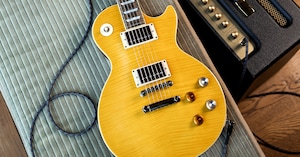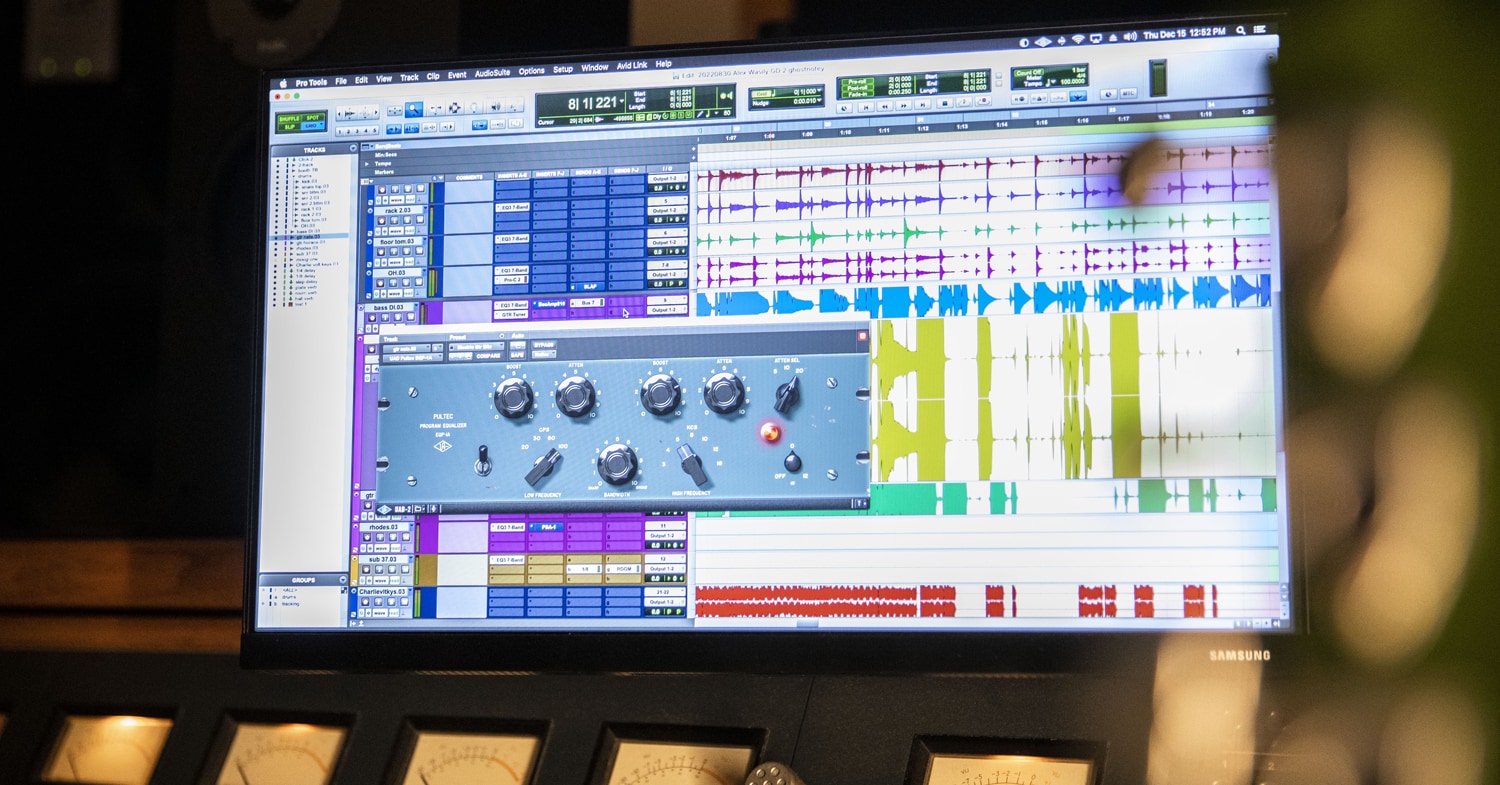Tone is the guitarist’s “Everything Everywhere All at Once,” and it’s a pivotal achievement in a player’s relationship with music when he or she finds their sound. However, when creating tracks for others to hear, one small caveat to your fateful moment of sonic self-discovery arises: A magnificent guitar tone only works magnificently if you can EQ it so that it fits superbly into a mix.
It’s simple logic. Unless it’s the unaccompanied section of “Eruption” by Van Halen, or another solo-guitar piece, listeners are not focusing on the sound of one guitar when they enjoy recorded music. They are listening to a complete song populated with vocals, drums, bass, keyboard, background vocals and other elements. So, when you mix a track, the challenge is to maintain the integrity of a stunning electric guitar sound—and all of the excitement, drama, emotion and dynamic appeal it brings—while simultaneously ensuring the tone enhances a song without diminishing its overall impact or stepping all over everything else.
Getting that gig right requires good ears, a basic understanding of frequency ranges and a sensitive, holistic approach to organizing a sound spectrum. You’ll also need some EQ chops, and, more specifically, to know how to utilize EQ to get an electric guitar to sit in a mix. Here’s some EQ education to help you craft electric guitar tones that play well with other instruments, but also shake things up like electrified demon banshees.
Table of Contents
The Tonal Anatomy of an Electric Guitar
Essential Electric Guitar Frequency Ranges
Using Parametric EQ Plug-ins on Electric Guitars
Going Retro With Vintage EQ Plug-ins
A Step-By-Step Guide to EQing Electric Guitars in a Mix
Pre-EQ Checklist for Electric Guitars
Mixing Electric Guitars
The Tonal Anatomy of an Electric Guitar
Whether you recorded yourself or another band and know what type of electric guitar was used to cut the track, or were presented with a song to mix and have no idea what guitars made the initial session, a basic knowledge of guitar models and critical frequencies will help you devise the best EQ strategy to rock the mix.
Although you may run up against a homemade or custom guitar—or even a 1960s “pawnshop prize” manufactured by some small, long-bankrupt Italian firm that was more concerned with eye-catching design than good tone—you’ll more than likely be dealing with one of the icons of guitar craft. These renowned models are sometimes mated with specific musical genres, but, quite frankly, the player and his or her approach is far more important than an equation such as Gibson Les Paul = rock, or Fender Telecaster = country. After all, the Clash’s Joe Strummer and metal maestro John 5 proved you can rock pretty hard with a Tele, and Les Paul played melodic jazz with his namesake guitar.
That said, the common-use cases for these guitars provide a good roadmap for the “typical” tones they can deliver. Fender Stratocaster and Telecaster models armed with single-coil pickups are prized for their clean, midrange-forward sounds. (On the other hand, super Strat models equipped with humbuckers are great for saturated-amp shredding.) Gibson Les Pauls are renowned for their warm and creamy mids, and the Gibson SG delivers a tight snarl. Fender Jaguar and Jazzmaster guitars are surf- and garage-rock-approved—thanks to their airy jangle. The Gretsch G6120 hollowbody punches out a round yet articulate twang, while the hollow Gibson ES-175 presents a resonant, rounded and sophisticated voice. But remember, the player’s signal chain—amp, pedals and other processing—can turn the above archetypes on their heads and serve up a tone that’s quite the opposite of what might be expected.
Essential Electric Guitar Frequency Ranges
The playable and most audible range of an in-tune electric guitar spans frequencies from 80Hz to 7kHz. But this doesn’t mean, “That’s all, folks.” In reality, electric guitar frequencies can extend a bit lower and higher to create texture, mood and atmosphere. Let’s take a look at the spectrum, and how some basic frequency ranges can best modify an electric guitar tone when boosted or cut.
20Hz–60Hz Oooo, don’t go there. This range is kick drum and electric bass territory. Boosting an electric guitar here may only add mud, woof and not-the-good-kind of boom.
80Hz–100Hz While this is the most-audible low-end range of an electric guitar, it’s also where a fair amount of rumble can appear, so take care with boosts—unless you are looking for the aural equivalent of Godzilla stomping across downtown Manhattan.
120Hz–300Hz Now, we are getting into a “safe” range for adding some robust beefiness to an electric guitar sound with a slight boost. You still need to take care, as too much of a good thing could make the guitar sound flabby and muffled.
400Hz–1kHz Here’s where an electric guitar begins to honk and bark with a nice punch.
1kHz–2.5kHz We’re still in the punch zone, but the tone begins to exhibit some nasal qualities.
3kHz–5kHz This is the articulation sector, where an electric guitar offers snap, coherence and pick attack.
5kHz–10kHz Look here for sparkle, jangle, glimmer and presence.
10kHz–12kHz Here’s a range that works best for clean electric guitar tones by adding air and dimension. Distorted/saturated tones in this frequency range tend to magnify fizz and high-end grit, which aren’t necessarily pleasing sounds.
12kHz–20kHz Think twice about boosting here. For one thing, much of the electric guitar’s sound isn’t up there. For another, unless your audience has perfect hearing, most people won’t even perceive that you cranked up, say, 18kHz by 6dB.
Using Parametric EQ Plug-ins on Electric Guitars
Now that you’re aware of the basic frequency ranges that can make electric guitars warm, punchy, present or airy, a parametric EQ plug-in is an indispensable tool for manipulating tones to fit righteously into your mix soundscape. For those more used to an amp’s tone controls, three-band EQ on pedals and mixer EQ with sweepable mids, parametric EQ delivers continuous control over numerous frequencies. In fact, you have the power to adjust the center or cutoff frequency, the Q or bandwidth, boost or cut, and more (depending on the features offered by the plug-in) for each frequency band. Obviously, when you’re trying to fit electric guitars into a dense—or even a sparse—mix, having such incisive and specific control over the frequencies that are causing problems, as well as the frequencies you wish to enhance, is incredibly beneficial.
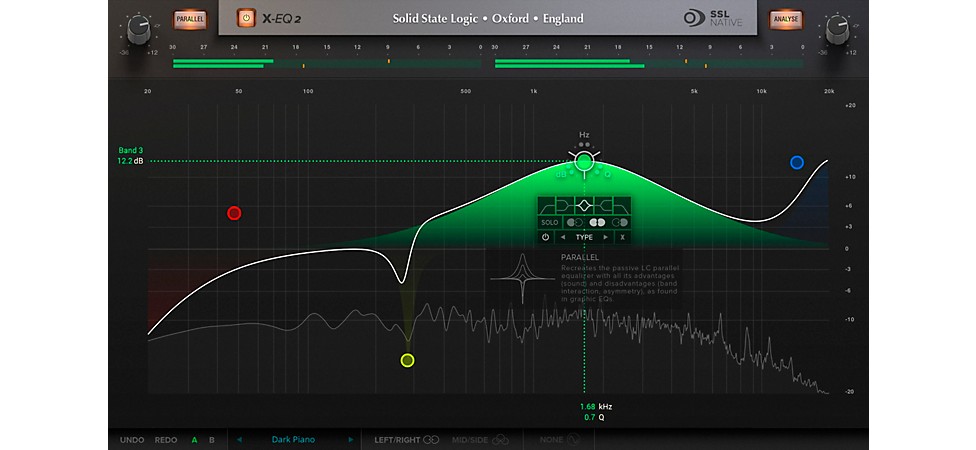
Pictured: Solid State Logic SSL Native X-EQ 2
A comprehensive parametric EQ plug-in to check out is the Solid State Logic Software SSL Native X-EQ 2. With its ability to focus on an extremely narrow Q (the selected center frequency of a bandwidth), X-EQ 2 lets you zero right in on an offending frequency—such as a pick attack that’s so bright it’s distracting—while leaving the rest of the tone sounding appropriately punchy and articulate. If you’ve placed yourself on a bit of a software-acquisition budget, an excellent yet more affordable alternative to the X-EQ 2 is the Eventide SplitEQ Parametric EQ Plug-in.
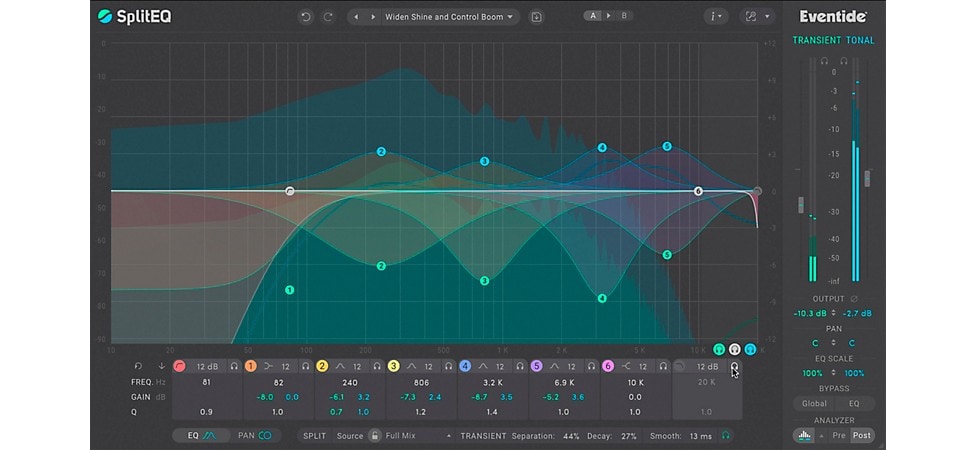
Pictured: Eventide SplitEQ Parametric EQ
For anyone new to parametric EQ who may have some trepidation at messing with frequency content, the Sound Radix SurferEQ 2 is like having a mix assistant who is also a magician. SurfEQ 2 actually “surfs” the audio to track the pitch of a monophonic instrument—in this case, an electric guitar—and automatically adjusts the frequency based on the notes being played. It’s a great starting point for clarifying the tone of a guitar and showing you what can be accomplished with the right EQ tweak. However, as you’re not refining the sound of the electric guitar alone—you’re looking to position the guitar into the frequency spectrum of an entire mix—you may need to experiment with SurfEQ 2’s other tone-shaping features to get the job done.
Going Retro With Vintage EQ Plug-ins
Parametric EQ plug-ins are perhaps the mightiest of the mighty for scrupulously adjusting frequency bands, but they are not the only option for fitting electric guitars into a mix. You can also choose to go with a vintage EQ emulation. These retro-flavored plug-ins are typically not as expansive as parametric EQs, but they model devices that worked just fine for engineers back in the 1960s and ’70s, and whatever you lose in tone-shaping precision you get back with torrents of vintage vibe. For example, the Arturia TridA-Pre emulates the rich, musical EQ of the Trident A-Range console at London’s Trident Studios, where classic tracks by Queen, T. Rex and David Bowie were recorded. The TridA-Pre has fixed frequency bands, so it’s not as versatile as a parametric EQ, but most of the frequencies critical to guitars are included, and the retro sound is absolutely delicious.
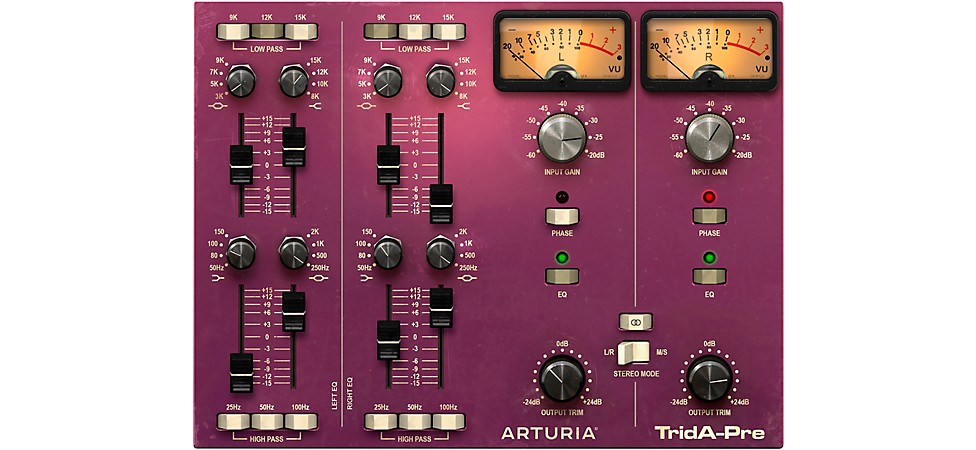
Pictured: Arturia TridA-Pre
Nothing against Britain, of course, but if you’d rather explore a classic American EQ, the Slate Digital FG-A Vintage EQ models the iconic ’60s-era API 550A. The original was a three-band EQ, but the FG-A ups the versatility factor by offering four bands.
Another outstanding and versatile model of vintage-studio vibe is the Universal Audio Pultec Passive EQ Collection UADx and UAD-2, which simulates the tube-driven funk of the original hardware devices. We say “devices,” because this collection gives you three classic Pultec EQs—each of which can provide ample tonal possibilities when tweaking electric guitars in a mix. You get the iconic Pultec EQP-1A for a fat, warm sound, the midrange-focused Pultec MEQ-5 that can really punch up guitar tones, and the Pultec HLF-3C, which provides high and low cut-off filters for more surgical precision. This is a fantastic collection for imparting retro colors to a mix without sacrificing detailed frequency alterations.
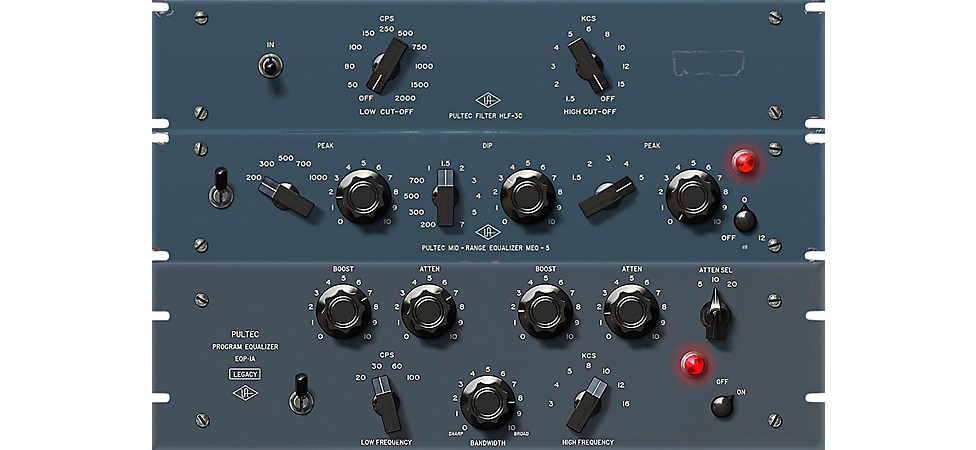
Pictured: Universal Audio Pultec Passive EQ Collection UADx and UAD-2
If the sound and flexibility of the Pultec collection inspires you, but you want to move up the retro vibe a couple of decades, the PSP Audioware PSP McQ delivers the ’70s majesty of classic MCI mixing board EQ and more. The four-band EQ of the McQ is augmented with adjustable low- and high-pass filters, a resonance control, optional bell filters and a SAT option to add some warm overdrive to the tone.
A Step-By-Step Guide to EQing Electric Guitars in a Mix
Once you are aware of the electric guitar’s frequency components and select your desired EQ plug-in (or plug-ins), it should be easy to carve out the bad stuff—meaning frequencies that obscure or fight with other instruments and vocals—and enhance the good bits that add punch, drive and excitement to the mix. Here are some simple yet crucial steps for constructing a spectacular soundscape.
Make Sure the Electric Guitar Track is in Phase
If the guitar was recorded with two or more microphones on the amplifier, or with a mic and a direct box, the sound may be out of phase when the tracks are blended together in the mix. The result is typically a weak, thin or inconsistent guitar tone. You can certainly dig into the guitar track using EQ, but toiling over a compromised sound isn’t often productive, and EQing a bad tone can sometimes leave you with a “slightly better bad tone.” Instead, use phase-alignment software to return the guitar to the solid, full and robust sound it deserves. You can learn more about fighting phase issues by reading our article, What Causes Phase Cancellation and How to Fix It.
Assess the Mix Soundscape
This is kind of a math problem, but don’t stress out. It’s a near-effortless calculation, and once you’re aware of the frequency arena, it all goes back to your ears, anyway. We’ve shared the fundamental frequency range of an electric guitar is 80Hz to 7kHz, so to strategize for a well-arranged sonic spectrum, you’ll need to determine the frequency ranges of the other elements in the mix. For example, the range of drums is typically 60Hz–20kHz, electric bass takes up 40Hz–400Hz for fundamentals and up to 4kHz for harmonics, vocals often reside at 100Hz–1kHz (fundamentals, male) and 300Hz–2kHz (fundamentals, female), an acoustic guitar sits around 300Hz–12kHz, an acoustic piano owns 20Hz–16kHz and a synth can gobble up just about every frequency.
Find a Spot for Each Mix Element
As you can surmise, the frequency range of an electric guitar can smear just about every mix element, except perhaps a crash cymbal. To ensure that every instrument has its own space in a mix, you can’t give everything the same amount of energy in the same frequency range. You may be able to achieve some sonic separation by using aggressive panning (positioning similar-sounding elements hard right and hard left in the stereo spectrum). However, this article is about EQ, so let’s look at what you can do with tonal adjustments to discretely isolate instruments. But first, consider bringing up all of the other elements before you add the electric guitar tracks. This approach lets you clearly hear where everything else is sitting before you add the complication of figuring out where the guitars should be positioned.
Cutting or Boosting Guitar Frequencies
With the guitar-less mix in front of you, bring up the electric guitar tracks and see what happens. Does the presence of the electric guitar fight with the vocal and obscure the articulation of the vocal melody and/or lyrics? Does it unbalance the onslaught of the drums by exaggerating or muddying the timbre of the snare, kick, toms or cymbals? Do you perceive any out-of-control low end, such as if certain frequencies of the electric guitar and bass (or kick drum) are reinforcing each other? Look for those areas of frequency clutter, but don’t initially do what a lot of musicians tend to do—which is boost the frequency of the electric guitar to smack down any instrument that gets in its way. Instead, try slightly cutting any frequencies in the electric guitar that are fighting with other mix elements. You obviously don’t want to neuter the awesome power of the electric guitar track, but you also have to make a decision regarding which element gets to “own” the frequency in question. For example, if it appears the electric guitar and snare drum are clashing, and you’ve cut 3kHz on the guitar to let the attack of the snare speak, but now you hate how the guitar sounds, try cutting 3kHz on the snare instead. Focus your ears and carve out the best sonic signatures for each instrument that don’t overly exaggerate any unwanted frequencies. It’s probably not going to be an easy job, but if you nail it, your mix is going to rule.
Take the Win
Sometimes, doing nothing is the best approach. In this case, if you bring up the electric guitar tracks and they fit perfectly, keep your hands off the EQ. You are in the presence of a mix miracle. Leave your home studio and buy a lottery ticket immediately—just in case your luck magnifies.
Pre-EQ Checklist for Electric Guitars
Although this article presents tips and suggestions for EQing electric guitars in a mix after they are recorded, there are some savvy sonic moves you can make before committing your tone to tape. The idea is to get your guitar sounding and playing as awesome as possible when you record it, so that any EQ tweaks you make in the mix merely help an already excellent tone fit beautifully into the entire soundscape, rather than having to remedy a less-than-stellar tone. For some deep tips on crafting guitar sounds that rule, absorb our tutorial on How to Record Electric Guitar.
Get Your Guitar Properly Setup
This is a step that tons of players forget before they lay down guitar tracks, and it is perhaps one of the most important. An electric guitar that has been battered through gigs and rehearsals is most likely not in racing trim. It may not intonate properly. There may be fret buzzes and/or fretting out (dead notes). Keeping it fastidiously in tune for an entire song becomes the impossible dream. Small wonder why successful producers such as Bob Ezrin (Alice Cooper, Pink Floyd, Peter Gabriel) won’t even let a session begin until the guitars are meticulously setup. “An excellent selection of instruments is at the center of every good, complex guitar recording,” Ezrin once told Guitar Player. He should know. If you’re unsure of how to go about getting the right setup for you, your local Guitar Center Repairs staff can help out.
Change Your Strings
Much like ensuring your guitar has a good setup before the session, you should probably change those ratty strings you’ve been playing on for months. You don’t want to go into the studio with dead, dull-sounding strings, but that’s not the only reason to replace them. For wound strings, different alloys used for the wrap produce distinctive timbres. For example, if you want a bright guitar sound, a round-wound string with a chrome or stainless steel wrap can get you there. However, if you prefer a warmer tone, a flatwound with a nickel wrap may be the right choice. For more information on string types, see our article How to Choose the Best Electric Guitar Strings.
Keep Your Amp Options Open for the Mix
While many guitarists simply lug their gig or rehearsal amp to the studio, an unfortunate pitfall is that it might not produce the right sound when everything is mixed together. This is that situation where a solo guitar tone might be fabulous all by itself, but it proves to be too bassy, too bright, too clean or too saturated when it’s combined with all the other tracks. Ensure your guitar sound will always work brilliantly in the context of the entire mix by taking a dedicated direct signal that can be sonically manipulated later. For example, you could choose to re-amp the tone by sending the dry, direct signal out to a different amplifier that’s miked up, or you can use an amp-modeling processor, such as IK Multimedia AmpliTube 5, which offers a smorgasbord of amps, cabinets, stompboxes, racks and more. There’s no reason to cling to an amp sound that’s undeniably the wrong sound for the mix.
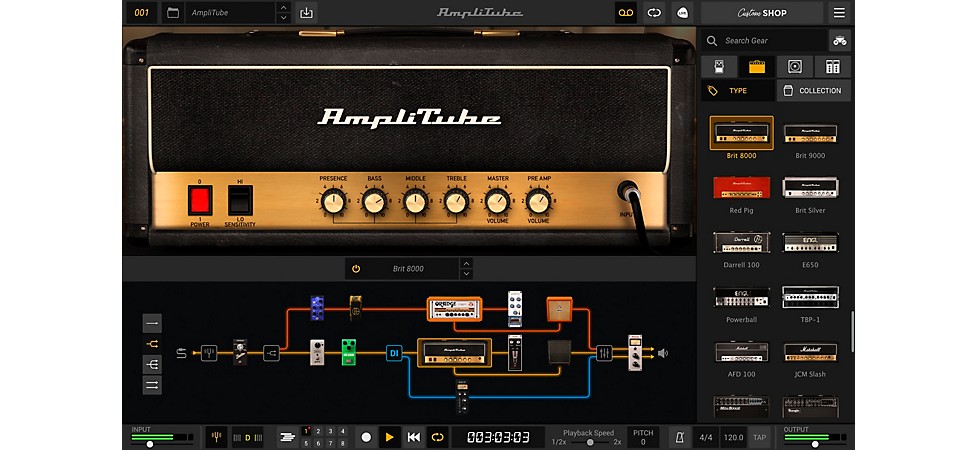
Pictured: IK Multimedia AmpliTube 5
Use Your Guitar’s Controls to Get New Sounds
The tone and volume knobs on your guitar that you probably never touch once you crank them full up can actually produce a surprising array of sounds. Icons such as Jeff Beck and Les Paul seemed to continuously adjust their guitar controls and pickup selector switches in real time during performances to create tonal dynamics, expressive colors and sonic surprises. This is proof that you don’t always need to rely solely on your amp and pedals to dial in a range of tones. Instead, embrace the (somewhat) lost art of turning the knobs on your guitar.
Explore the Sounds of Different Picks
What guitarist wouldn’t want a platoon of different guitars, amps and stompboxes to transform chasing sound into a game of mix and match. But there’s a much more affordable—and compact—tactic to changing guitar tone: Use an assortment of guitar picks. While not as drastic an alteration as unleashing a parametric EQ on an audio signal, a pick’s shape, thickness and composition can affect guitar tone. For example, thin picks produce a nice snap that’s great for strumming, mediums deliver articulate and commanding tones, and heavys can elevate solos and power chords with less pick noise and a bright attack. Also, explore materials, such as bone (nice mids), graphite (bright and punchy), ceramic (scooped mids and nice lows), nylon (tight and clear) and other types. Furthermore, picks with rounded points typically offer a warm, mellow tone, while sharper points can generate a brighter sound. You can easily audition different picks—and the tonal effects they give your playing—with a Dunlop Variety Pack Medium/Heavy or Dunlop Variety Pack Light/Medium.
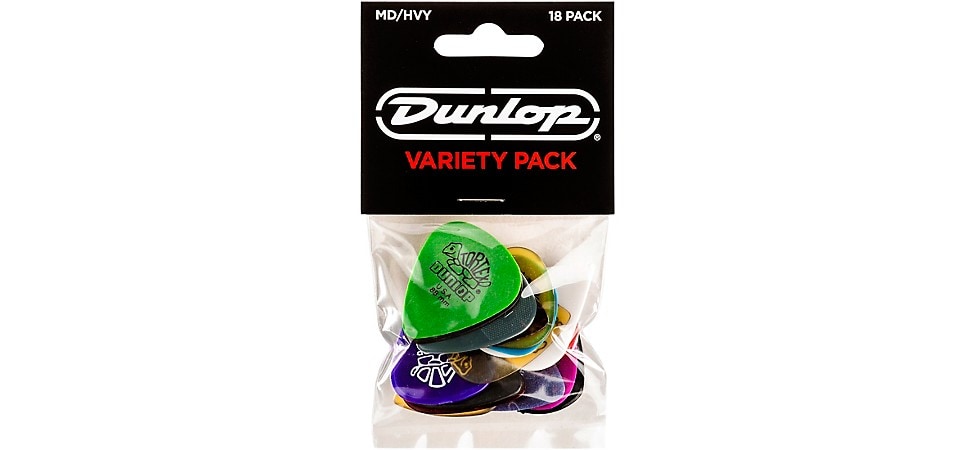
Pictured: Dunlop Pick Variety Pack 18/PLYPK Medium/Heavy
Mixing Electric Guitars
Enthralling mixes are thrill rides of dynamic interest, chock-full of aural and melodic excitement. So, when EQing electric guitars in a mix, you could do worse than follow the wisdom of “mix master” Muhammad Ali, who famously advised, “Float like a butterfly, sting like a bee.” In other words, when the mix needs to take a dynamic breath with, say, a clean, shimmery guitar, EQ the part appropriately with a cut in the mids that sounds lush and beautiful, rather than an aggressive boost in the mid- and high-end range. However, for a savage “sting” via an overdriven guitar riff that surprises the listener and energizes the track, unleash an EQ boost that best mirrors the part—perhaps 3dB boosts in the low and high midrange frequencies. Envisioning a mix as an emotional narrative, rather than simply a collection of frequency bands, is a good methodology for getting your track to stand out and seduce an audience. There’s a lot of competition for ears out there, so make your mix astounding.
For reference, education and context, it’s always a good idea to immerse yourself in amazing mixes that feature guitar. Producer George Martin was a virtuoso at mixing guitars into classic Beatles tracks, and the recordings by more contemporary studio masterminds such as Andrew Watt, Sylvia Massy, Jack White, St. Vincent and Italian experimental guitarist Sara Ardizzoni offer compelling examples of stunning guitar tones that stand their ground, but don’t overwhelm the entire soundscape.
Now, do you have another mix ready to go that includes acoustic guitar textures or solo-acoustic parts? Get some flat-top factoids and tips from our companion article, How to EQ Acoustic Guitar in a Mix.

